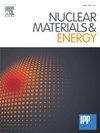Glow Discharge Boronization and Real-Time Boronization Using an Impurity Powder Dropper in LHD
IF 2.3
2区 物理与天体物理
Q1 NUCLEAR SCIENCE & TECHNOLOGY
引用次数: 0
Abstract
In the Large Helical Device (LHD), boronization is utilized for wall conditioning, employing two distinct methods: glow discharge using diborane gas and the injection of boron powder into the plasma via an impurity powder dropper (IPD). Glow discharge boronization is conducted after maintenance when the vacuum vessel is exposed to air and just before the start of an experimental campaign. In contrast, real-time boronization using the IPD is performed during discharges. The distribution of boron on plasma-facing components was assessed through long-term material probes in the case of glow discharge and through numerical simulations for the IPD method. Results indicated non-uniform boron distributions in both cases. The impact of these boronization techniques on impurity levels and the lifetime of their effects were also examined. Both methods effectively reduced oxygen and iron in the plasma, with the iron impurities originating from the first wall. For glow discharge boronization, the reduction in oxygen levels persisted until the end of the experimental campaign, whereas the reduction in iron levels only lasted a few days. In the case of boron injection during long pulse discharges exceeding 200 s, the suppression of oxygen and iron was observed. The effect on iron quickly diminished within several seconds after the injection ended, whereas the effect on oxygen lasted more than 100 s. The difference in the lifetimes of the boronization effects is further discussed.
求助全文
约1分钟内获得全文
求助全文
来源期刊

Nuclear Materials and Energy
Materials Science-Materials Science (miscellaneous)
CiteScore
3.70
自引率
15.40%
发文量
175
审稿时长
20 weeks
期刊介绍:
The open-access journal Nuclear Materials and Energy is devoted to the growing field of research for material application in the production of nuclear energy. Nuclear Materials and Energy publishes original research articles of up to 6 pages in length.
 求助内容:
求助内容: 应助结果提醒方式:
应助结果提醒方式:


